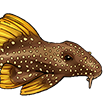| Scientific Name | Ancistrus martini Schultz, 1944 |
| Common Names | Martin's Bristlenose Pleco Bristlenose Catfish |
| Type Locality | Río Táchira, 7 kilometers north of San Antonio, Río Catatumbo system, Venezuela. |
| Synonym(s) | Ancistrus bodenhameri, Ancistrus brevifilis bodenhameri, Ancistrus triradiatus martini |
| Pronunciation | an SISS truss |
| Etymology | The name Ancistrus is derived from the Greek word agkistron, meaning hook, in reference to the interopercular odontodes that are hooked. Named after Bethea Martin of the Lago Petroleum Corporation, who aided Schultz during fish collection in Venezuela. |
| Size | 89mm or 3.5" SL. Find near, nearer or same sized spp. |
| Identification | Mature males and sometimes females have soft tentacles (bushy fleshy growths) on the snout - this is unique to the genus Ancistrus. Head and anterior body broad, tapering back to tail. Body brown to black, with distinct (not diffuse) light spots covering the head, barbels and body, with head spots smaller anteriorly and enlarging posteriorly. Abdomen also dark, covered with larger, ovoid pale spots which may fuse to form vermiculations. Fins covered with rows of alternating dark and light spots on rays. The dark spots can spread onto fin membranes, forming parallel dark bands. A single dark spot at dorsal fin base, between dorsal spine and first soft ray. A pale bar across the caudal peduncle, at the base of the caudal fin rays. Upper and lower tips of caudal fin, white to yellow-orange. |
| Sexing | Males develop soft tentacles on the head and while sometimes females also do, it is never to the grand extent of those found on that of the conspecific male. |
| General Remarks | Ancistrus bodenhameri was synonymized with A. martini by Taphorn et al., 2013 (Zootaxa, 3641(4): 343-370). |
| Distribution | South America: Zulia River basin in the Catatumbo River drainage, Lake Maracaibo drainage, Venezuela. Lake Maracaibo, Catatumbo, Zulia (click on these areas to find other species found there) Lake Maracaibo, Catatumbo (click on these areas to find other species found there) Lake Maracaibo (click on these areas to find other species found there) Login to view the map. |
| IUCN Red List Category | Least Concern , range map and more is available on the IUCN species page. Last assessed 2021. |
| Feeding | Ancistrus should be fed mainly on vegetarian foods. Prepared foods include algae wafers and spirulina based sinking food. Vegetables such as courgette/zucchini, and (English) cucumber are an excellent addition to the diet, along with the odd, small amount of more meaty foods. User data. |
| Compatibility | A good complement to most aquariums, they are not aggressive to other species. Males may fight over territory if kept in too small a tank. |
| Suggested Tankmates | Appropriate with most community fish that aren't overly big or aggressive. |
| Breeding | Unreported. |
| Breeding Reports | There is but a single breeding report, read it here. |
| Reference | Proceedings of the United States National Museum v. 94 (no. 3172), pp 302, Pl. 9 (figs. C-D). |
| Registered Keepers | There are 5 registered keepers, view all "my cats" data. |
| Wishlists | Love this species? Click the heart to add it to your wish list. There is no wish to keep this species. |
| Spotters | Spotted this species somewhere? Click the binoculars! There are 3 records of this fish being seen, view them all. |
| Forum BBCode | |
| Search for A. martini | |
| Look up A. martini on AquaticRepublic.com | |
 | Look up A. martini on Fishbase |
 | Look up A. martini on Encyclopedia of Life |
 | Look up A. martini on Global Biodiversity Information Facility |
| LFS label creator ARN ref:1.4.4.2019 | |
| Last Update | 2025 Jan 01 12:06 (species record created: 2008 May 31 04:24) |





/siluriformes/loricariidae/ancistrus/martini/1.jpg)
/siluriformes/loricariidae/ancistrus/martini/2.jpg)
/siluriformes/loricariidae/ancistrus/martini/3.jpg)
/siluriformes/loricariidae/ancistrus/martini/4.jpg)
/siluriformes/loricariidae/ancistrus/martini/5.jpg)
/siluriformes/loricariidae/ancistrus/martini/6.jpg)
/siluriformes/loricariidae/ancistrus/martini/7.jpg)
/siluriformes/loricariidae/ancistrus/martini/8.jpg)
/siluriformes/loricariidae/ancistrus/martini/9.jpg)
/siluriformes/loricariidae/ancistrus/martini/10.jpg)